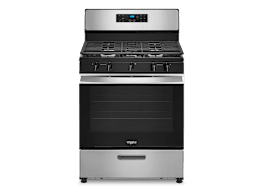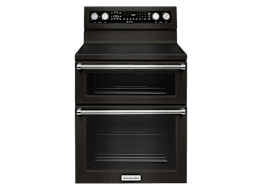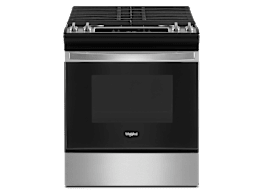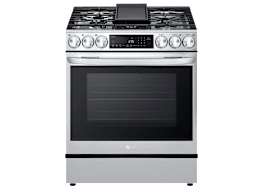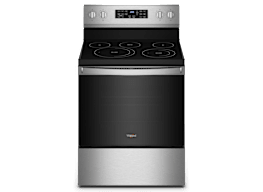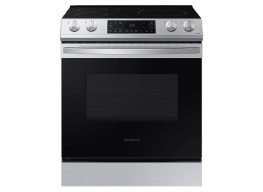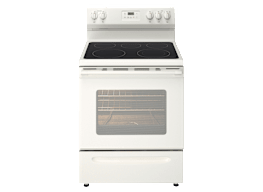Pros and Cons of Induction Cooktops and Ranges
They're sleek. They're precise. And they can boil water in about half the time of a conventional stove. But is one right for your kitchen?
When you shop through retailer links on our site, we may earn affiliate commissions. 100% of the fees we collect are used to support our nonprofit mission. Learn more.

Some home chefs would say induction cooktops and ranges are the way of the future, offering a safer and more energy-efficient way of cooking.
An induction cooktop is a special type of electric cooktop that gets its power and precision from induction technology. This means it generates energy from an electromagnetic field below the glass cooktop surface, which then transfers current directly to magnetic cookware, causing it to heat up.
Induction cooktops and ranges generally outperform every other kind of range in Consumer Reports tests. In fact, every induction cooktop and induction range tested through our range lab delivers fast cooktop heat and superb simmering. What’s more, if you buy a new induction cooktop or range, you may be eligible for financial incentives created by the Inflation Reduction Act.
What Induction Is—and What It Isn’t
Induction cooktops and ranges look a lot like typical glass-top electric models, except that they cook via a magnetic field. On most 30-inch cooktops, the field is concentrated into four spots (or elements), and they otherwise function just like the elements on an electric cooktop or the burners on gas.
As for the ovens in induction ranges, they broil and bake just as other electric ovens do, but their capabilities will differ from model to model. High-end options, for instance, might have features like convection, WiFi connectivity, and even in-oven cameras so you can monitor whatever you’re baking with a smartphone. Entry-level options will have many of the same features you’d find on regular electrics, like storage or warming drawers, adjustable racks, and a self-cleaning mode.
To learn more about induction, see our cooktop and range buying guides. Additionally, our ratings for induction cooktops and ranges highlight each appliance’s performance and specifications.
Induction Cooktops and Ranges: the Pros
There are plenty of things to love about induction ranges, whether you’re obsessed with perfectly prepped food or interested in energy efficiency. Here’s how they compare with gas and conventional electric ranges.
They’re more environmentally friendly. An induction stove is 5 to 10 percent more energy-efficient than conventional electric stoves and about three times more efficient than gas stoves. And unlike gas, it’s better for indoor air quality.
Induction Cooktops and Ranges: the Cons
Before you shop for an induction cooktop or range, consider your budget and your cooking habits. Here’s what you need to know.
Induction cooking feels very different from cooking with gas. Some avid cooks really love cooking on a flame and the immediate visual feedback they get from it at the turn of a knob. No electric option, even induction, can replicate that feel. In fact, because the electromagnetic field on an induction cooktop doesn’t create a glow, you won’t even know it’s on. That’s why manufacturers have started adding virtual flames and other lighting cues.
It can get expensive when you convert from gas to electric. If you’re replacing an electric range, the swap is simple. Induction cooktops and ranges use the same outlet as a standard electric range or cooktop. But if you’re switching from gas, expect to pay an electrician several hundred dollars or more to install the necessary outlet.
You need the right cookware. While most of the cookware in our ratings is induction-compatible, some pans—including those made of aluminum and anodized aluminum—won’t work on induction. Most others, including stainless steel and cast iron, will. If you’re shopping for cookware for induction cooktops, look for pots and pans marked “induction-compatible.” To determine whether your existing arsenal of cookware will work with an induction range, see if a magnet strongly sticks to the bottom of your pots. If it does, they’ll work on an induction burner.
It might emit a sound. “A buzz or hum is common, and often louder at higher settings,” says Tara Casaregola, who oversees the testing of ranges and cooktops for Consumer Reports. “And we often hear the clicking of element electronics at lower settings, as well as the sound of the cooling fan for the electronics.” Heavy flat-bottomed pans help reduce the vibrations that cause this buzz.
You may need an analog thermometer. The magnetic field of an induction cooktop can interfere with a digital meat thermometer.
Induction cooktops and ranges are typically more expensive than conventional electric models. But prices have continued to drop in recent years despite inflation, with some induction ranges in our ratings selling for about $1,000. Additionally, buying a new induction cooktop or range may make you eligible for rebates from the Inflation Reduction Act.
To learn more about induction, see our cooktop and range buying guides. CR members can also browse our full list of ratings for induction cooktops and ranges. Here, we’ve highlighted the best induction range in our ratings, as well as the best 30-inch and 36-inch induction cooktops.
Best Induction Range From CR's Tests
An induction range is best for kitchens with limited space because it packs a cooktop and oven into a single appliance. Here’s a standout model from our ratings.
Best Induction Cooktops From CR's Tests
If you’ve got the space, a cooktop (along with a wall oven that you buy separately) can be a nice way to break up cooking areas in your kitchen. The two cooktops below are exceptional performers from our tests.
@consumerreports When it comes to our tests, induction ranges are tough to beat. See ratings and reviews at CR.org/ranges. #kitchentok #kitchentiktok #cooktop ♬ original sound - Consumer Reports


















